| Sustainability – General | ||
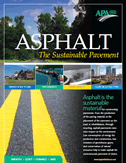 | Asphalt, The Sustainable Pavement (Brochure and Inserts) Asphalt is the sustainable pavement for construction pavements. Low consumption of energy for production and construction, low emission of greenhouse gases, and conservation of natural resources help make the asphalt the environmental pavement of choice. This brochure and inserts show how. | |
 | Asphalt Pavements & the LEED Green Building System This informational tri-fold brochure outlines the various ways which asphalt pavements may be used to obtain or contribute to LEED credits. It provides a summary of how LEED works and includes a scorecard that contractors can use as a guide to earning LEED credits for asphalt pavements. Tri-fold. | |
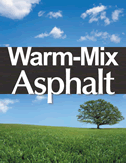 | Warm-Mix Asphalt: The Future of Asphalt This highly readable executive summary of warm-mix asphalt technologies sets out the current state of the practice in an attractive format. It covers the origins of warm mix and explains how the technologies work. The brochure also explores the potential impact of WMA on recycling, benefits to the environment, and construction benefits. 6 pages. | |
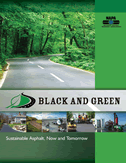 | Black and Green: Sustainable Asphalt, Now and Tomorrow The asphalt pavement industry’s first-ever sustainability report. The report discusses some technologies including warm-mix asphalt, reuse/recycling, porous asphalt, and Perpetual Pavements. It also highlights the ways in which the asphalt industry’s everyday practices address climate change, improve air quality and water quality, provide green jobs, and reduce the carbon footprint of pavements. 8 pages. | |
 | Benefits of Asphalt The attractive tri-fold brochure gives a bulleted summary of both environmental and performance advantages of asphalt. Tri-fold. | |
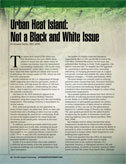 | “Urban Heat Island: Not a Black and White Issue” Although pavement color may be one indicator of surface temperatures, it is not a good indicator of potential impact on overall UHI. 2 pages. | |
| Porous Pavement | ||
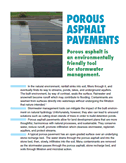 | Porous Asphalt Pavements Brochure This full-color, lavishly illustrated, executive summary brochure serves as an excellent introduction to porous pavements. It touches on water quality, site planning issues, design, materials, cost, and adaptations for various climates. 6 pages. | |
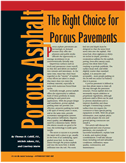 | “Porous Asphalt: The Right Choice for Porous Pavements” This article from HMAT magazine is a comprehensive resource on porous pavements. It discusses the background and costs of porous pavements, cites examples of successful installations, explains how they work, and explores design considerations. It also discusses issues including soil and subsurface conditions, infiltration, water quality, construction, and maintenance. 10 pages. | |
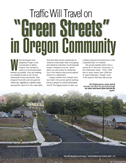 | “Traffic Will Travel on Green Streets in Oregon Community” Pringle Creek is a 32-acre community in Salem, Oregon that is designed to be environmentally friendly. Among the green features is a road network constructed from porous asphalt. This HMAT magazine article explores how the developers brought sustainability to the neighborhood. 2 pages. | |
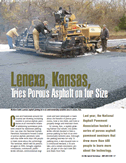 | “Lenexa, Kansas Tries Porous Asphalt On for Size” City officials in a rapidly growing suburb of Kansas City decided to put a porous parking lot in an environmentally sensitive area, next to a constructed wetland, a 35-acre lake, and a stream restoration project. This HMAT magazine article discusses the project. 3 pages. | |
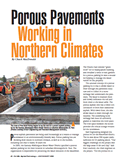 | “Porous Pavements Working in Northern Climates” Use of porous pavements doesn’t have to be confined to the Sunbelt. This HMAT magazine article discusses successful parking lots in Massachusetts, Michigan, and Minnesota. 3 pages. | |
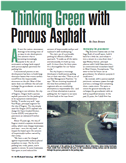 | Thinking Green with Porous Asphalt From HMAT magazine, an article on the basics of porous pavements. 4 pages. | |
| Quiet Pavement | ||
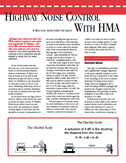 | “Highway Noise Control with HMA” From the Fall 2002 issue of Asphalt magazine, this article describes how roadway noise is measured and the benefits of using HMA (hot-mix asphalt) for noise reduction. 2 pages. | |
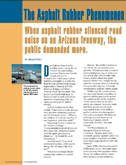 | “The Asphalt Rubber Phenomenon” This article from HMAT magazine describes the very positive public reaction when asphalt rubber silenced road noise on Arizona’s Superstition Freeway (US 60). 4 pages. | |
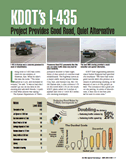 | “KDOT’s I-435 Project Provides Good Road, Quiet Alternative” When Kansas DOT rehabilitated a concrete interstate with an asphalt overlay and interlayer, one of the benefits for nearly residents was a dramatic reduction in road noise. This article from HMAT magazine tells the story. 2 pages. | |
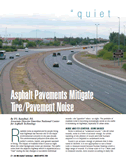 | “Asphalt Pavements Mitigate Tire/Pavement Noise” This article from HMAT magazine discusses how research shows asphalt surfaces are a cost-effective way to reduce traffic noise. It covers the gamut, from the science of sound to pointers on how pavements can be engineered to reduce noise. 8 pages. | |
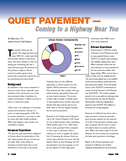 | “Quiet Pavement – Coming to a Highway Near You” Across the country, neighbors are asking for quieter highways – and getting them. This article from Asphalt magazine examines quiet-pavement technologies and how they are being applied to improve quality of life in communities. 2 pages. | |
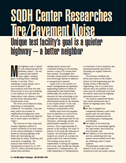 | “SQDH Center Researches Tire-Pavement Noise” The Institute for Safe, Quiet, Durable Highways (SQDH Center) at Purdue University has a unique lab for testing pavement noise. This article from HMAT magazines discusses the methodology. 2 pages. | |
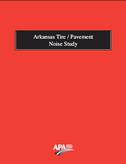 | Arkansas Tire/Pavement Noise Study The purpose of this paper is to present the results of noise testing accomplished by the National Center for Asphalt Technology (NCAT) using a close-proximity noise trailer. The paper discusses the nature of tire/pavement noise and the results of testing selected pavements in Arkansas. 32 pages. | |
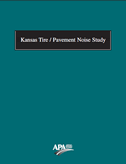 | Kansas Tire/Pavement Noise Study This paper presents the results of noise testing by the National Center for Asphalt Technology (NCAT) using a close-proximity noise trailer. The paper discusses the nature of tire/pavement noise and the results of testing selected pavements on I-435 near Kansas City. 27 pages. | |
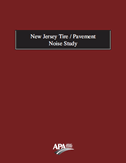 | New Jersey Tire/Pavement Noise Study The purpose of this paper is to present the results of noise testing accomplished by the National Center for Asphalt Technology (NCAT) using a close-proximity noise trailer. The paper discusses the nature of tire/pavement noise and the results of testing selected pavements in New Jersey. 24 pages. | |
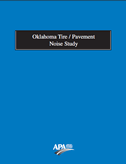 | Oklahoma Tire/Pavement Noise Study This paper presents the results of noise testing accomplished by the National Center for Asphalt Technology (NCAT) using a close-proximity noise trailer. The paper discusses the nature of tire/pavement noise and the results of testing selected pavements in Oklahoma. 34 pages. | |
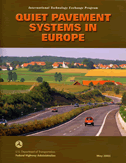 | Quiet Pavement Systems in Europe Part of the International Technology Exchange Program, this document features information from Denmark, The Netherlands, France, Italy and the United Kingdom concerning the governmental policies, pavement technology, noise measurements and research they are using to address tire/pavement noise. 36 pages. | |
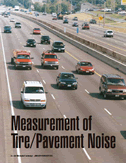 | “Measurement of Tire/Pavement Noise” Researchers typically use one of two methodologies to measure road noise: near-field measurement or a close-proximity method. This article from HMAT magazine examines the two approaches and discusses how NCAT applied them to field measurements of more than 200 pavements in 16 states. Their results show that overall, asphalt pavements are quieter. 6 pages. | |